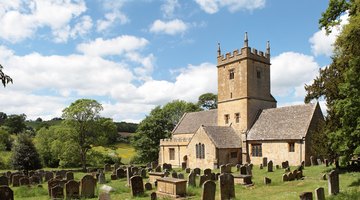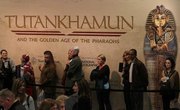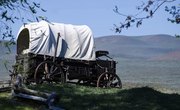In the Elizabethan era (1558 to 1603) death arrived much earlier for the majority of the population compared to today. In England, only around 10 percent of the population lived beyond 60 years, and the infant mortality rate was high, with only about seven or eight children out of every 10 reaching 10 years of age. The average life expectancy was 48 years and disease was a common cause of death.
Preparing the Body for Burial
The tolling of the church bell told a community that someone was about to die. This was known as the "passing bell." Anyone hearing it was supposed to pray for the person about to die. The church bell then rang once to let people know that the person had died. During the Elizabethan period, a midwife performed some of the duties now done by funeral directors, washing the body and wrapping it in a plain sheet. The body was then placed in a coffin if the family could afford it. The poor were usually buried wrapped in a woolen shroud.
Funeral Customs
A funeral was a community affair. Attendees formed a procession behind those carrying the corpse. Processions accompanying the body of an aristocrat usually displayed banners with the family coat of arms. Church bells rang as the procession approached the churchyard and the priest met the procession at the gate rather than inside the church. The funerals of wealthy citizens were often an occasion for giving alms to the poor. It was also tradition to provide a feast after the funeral and invite the whole community. The less well-off had a more limited feast, which typically consisted of cakes and ale. Flowers were rare at funerals. Sometimes flowers were thrown in the grave of a child or young woman and herbs in the graves of adult men and women.
Mourning Clothes
Elizabethans wore black for funerals. Only the wealthiest families could afford to provide black mourning clothes to the invited mourners, which included servants and other dependents. Black accessories were also traditional. These included ribbons, neck ruffs, gloves and stockings. Some mourners blackened the soles of their shoes. Mourners might also wear a sprig of rosemary in a hatband. The Elizabethans also had a tradition of wearing mourning rings made in the shape of a skull, cross or coffin as a way of remembering the dead.
Graves
Wealthy Elizabethans could afford burial inside the church. England's cathedrals have a number of elaborate tombs inside, many of them effigies of the person in stone or bronze. The poor were buried outside in the churchyard without any grave marker or headstone. People who committed suicide weren't allowed a burial inside the churchyard. They had to be buried outside in what was called "unhallowed" ground, meaning that it hadn't been blessed or made holy.
Related Articles
References
Writer Bio
Based in London, Eleanor McKenzie has been writing lifestyle-related books and articles since 1998. Her articles have appeared in the "Palm Beach Times" and she is the author of numerous books published by Hamlyn U.K., including "Healing Reiki" and "Pilates System." She holds a Master of Arts in informational studies from London University.











